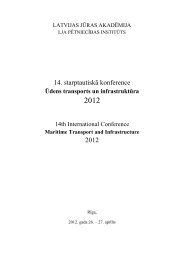Latvian Maritime academy
Latvian Maritime academy
Latvian Maritime academy
You also want an ePaper? Increase the reach of your titles
YUMPU automatically turns print PDFs into web optimized ePapers that Google loves.
will impose the change on them.” [15] It means that MET providers have to think and react to these<br />
aspects of change.<br />
It is now left for the education institutions to adapt to new techniques in teaching. DL is not a theory<br />
or a phenomenon that will fade away. On the contrary, the technology revolution is here to stay. Hence,<br />
traditional classroom teachers should also smoothly adapt to the new technologies other than resist them.<br />
This will ensure them a place in the coming world of DL. It is noted [19] that “in the 21 st century, the<br />
maritime education and training community finds itself facing an explosion of new developments in<br />
communication tools, simulation, software training programs and expanding use of computers linked to<br />
the Internet and the Web.” Currently education is becoming globalized, and it is treated as a commodity,<br />
where the customer is the student. Lewarn (2001) states that globalization of education will lead to a<br />
quick downfall of the traditional education and will induce a giant leap towards borderless education [15].<br />
In addition, maritime educational institutions also face the challenge today of utilising new technology,<br />
communications and teaching methodologies in order to enhance the learning environment of tomorrow.<br />
Whether offering on-campus or off-campus courses, “computers and IT resources are rapidly becoming<br />
indispensable delivery tools.” [19]<br />
In order to meet the challenge MET institutions must adopt the new techniques and hopefully they<br />
will do that not on the account of quality. P. Muirhead believes that the “quality of academic standards &<br />
credibility is dependant upon many factors. In today’s world, provision of up-to-minute computing and<br />
Internet services is crucial for education.” [18] Traditionally, maritime educators have focused on the<br />
technical aspects of their systems, but with the current strong changes, providers of MET will need to take<br />
on these changes in order to maintain their role and to be able to reserve a seat among others in the<br />
educational world, otherwise, they will simply perish. One important aspect for DL, is that it can provide<br />
life-long learning. Hence changing that was known to be “just in case” to “just in time” which means life<br />
long learning only provided through DL [15; 24].<br />
However, for DL to be fully adopted and implemented there is a need for legal guidelines set and<br />
recognition by the IMO. This would avoid conflict between providers and maritime administrations. A<br />
clear-cut definition of the contents of knowledge and skills constituting the DL subject should also be<br />
clarified by IMO.<br />
Conclusions<br />
Safety on board tankers requires more courses such as tanker safety, advanced fire fighting and<br />
tanker operation. Subsequently, a simulator for training tanker officers and engineers is required as well.<br />
Different interfaces result in increased training needs which are unpractical in many circumstances.<br />
Accordingly, if standardization of interfaces and symbols is not achieved, training for specific type is<br />
required to achieve safe operations.<br />
STCW 2010, in educational terms, is a welcome change, as it should finally bring maritime<br />
education into line with accepted educational practice and needs of the industry. Nevertheless, the proper<br />
and up to date implementation lays in the hands of parties to the convention. Furthermore, requirements<br />
for training on the use of such electronic systems must be included and detailed in the STCW, in order to<br />
emphasize their use in assisting the decision making process rather than simply operating equipment<br />
itself.<br />
References<br />
1. Amendments: STCW 2010. What you need to know. Available (accessed on 16.12.2012):<br />
http://www.safety4sea.com/analysis/1/16/stcw-2010-amendments-:-what-you-need-to-know<br />
2. Bennet, S. Implementation of STCW 95 from the perspective of the international shipping<br />
industry. In: IMLA Conference on <strong>Maritime</strong> Education and Training. Proceedings of the 11 th Conference<br />
(Malmö, Sweden, August 2000).<br />
3. Binnington, J. R. STCW the Debate. The Baltic Company News, 2000.<br />
4. Dinu, D., Jurian, M. Implementing distance learning in Romanian <strong>Maritime</strong> education and<br />
training. In: IMLA Conference on <strong>Maritime</strong> Education and Training. Proceedings of the 11 th Conference<br />
(Malmö, Sweden, August 2000).<br />
5. Germanchir Lloyd. STCW: Responsibilities of Administrations. 2002. Available (accessed on<br />
11.01.2004): http://www.germanlloyd.de/infoServices/seminars/stcw/responseadmin.html<br />
34
















